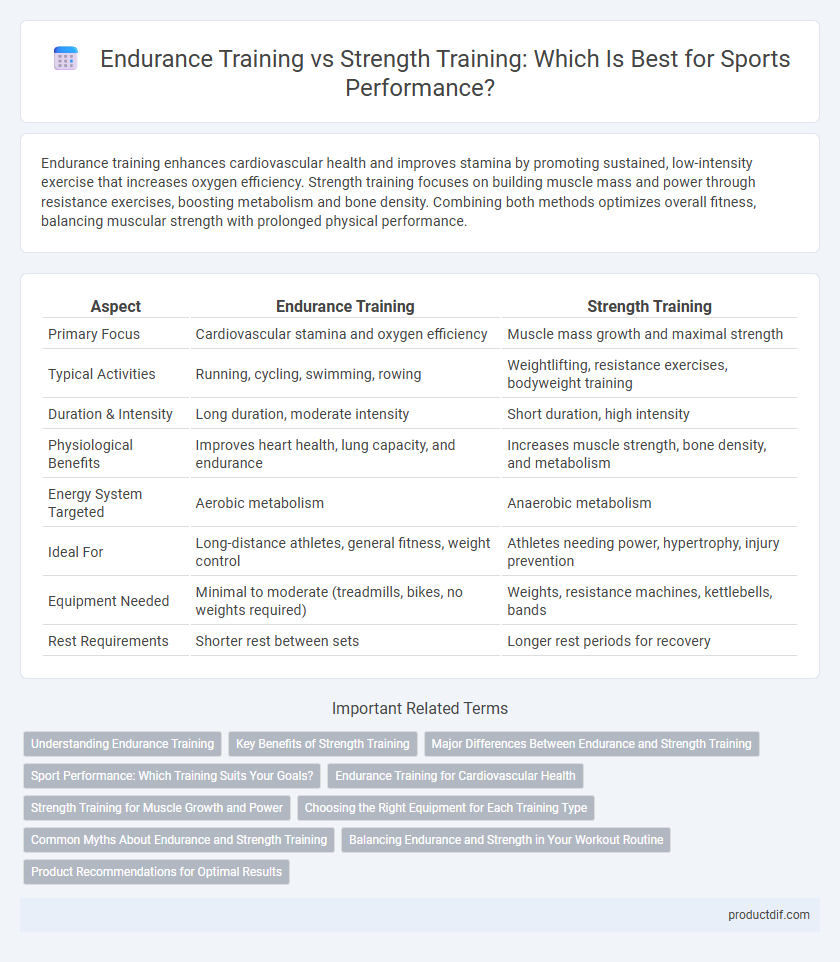Endurance training enhances cardiovascular health and improves stamina by promoting sustained, low-intensity exercise that increases oxygen efficiency. Strength training focuses on building muscle mass and power through resistance exercises, boosting metabolism and bone density. Combining both methods optimizes overall fitness, balancing muscular strength with prolonged physical performance.
Table of Comparison
| Aspect | Endurance Training | Strength Training |
|---|---|---|
| Primary Focus | Cardiovascular stamina and oxygen efficiency | Muscle mass growth and maximal strength |
| Typical Activities | Running, cycling, swimming, rowing | Weightlifting, resistance exercises, bodyweight training |
| Duration & Intensity | Long duration, moderate intensity | Short duration, high intensity |
| Physiological Benefits | Improves heart health, lung capacity, and endurance | Increases muscle strength, bone density, and metabolism |
| Energy System Targeted | Aerobic metabolism | Anaerobic metabolism |
| Ideal For | Long-distance athletes, general fitness, weight control | Athletes needing power, hypertrophy, injury prevention |
| Equipment Needed | Minimal to moderate (treadmills, bikes, no weights required) | Weights, resistance machines, kettlebells, bands |
| Rest Requirements | Shorter rest between sets | Longer rest periods for recovery |
Understanding Endurance Training
Endurance training enhances cardiovascular efficiency, promoting prolonged physical activity by improving oxygen delivery to muscles. This type of training includes activities like long-distance running, cycling, and swimming, which increase stamina and aerobic capacity. Focusing on endurance helps athletes sustain performance over extended periods, reducing fatigue and boosting overall athletic resilience.
Key Benefits of Strength Training
Strength training enhances muscle mass, bone density, and metabolic rate, contributing to improved overall physical performance and injury prevention. It supports joint stability and muscular endurance, which are crucial for athletic longevity and daily functional activities. Consistent strength training also boosts hormonal balance and cardiovascular health, optimizing both endurance and recovery phases.
Major Differences Between Endurance and Strength Training
Endurance training primarily targets the cardiovascular system by enhancing aerobic capacity and muscle stamina through prolonged, low-to-moderate intensity activities like running or cycling. Strength training focuses on increasing muscle mass, power, and anaerobic capacity by utilizing resistance exercises such as weightlifting or bodyweight movements. Key differences include energy system engagement, muscle fiber recruitment, and training duration, with endurance favoring slow-twitch fibers and sustained effort, while strength emphasizes fast-twitch fibers and short bursts of high intensity.
Sport Performance: Which Training Suits Your Goals?
Endurance training enhances cardiovascular capacity and stamina crucial for prolonged athletic performance, making it ideal for sports like long-distance running or cycling. Strength training builds muscle power and explosiveness, directly improving performance in activities requiring bursts of speed or heavy lifting such as sprinting or weightlifting. Choosing between endurance and strength training depends on your specific sport goals, with many athletes combining both to optimize overall physical performance.
Endurance Training for Cardiovascular Health
Endurance training, characterized by activities such as running, cycling, and swimming, significantly enhances cardiovascular health by improving heart efficiency, increasing lung capacity, and promoting better blood circulation. This type of training stimulates the growth of new blood vessels and strengthens the heart muscle, reducing the risk of heart disease and hypertension. Consistent endurance exercise also helps regulate blood sugar levels and lowers cholesterol, contributing to overall cardiovascular wellness.
Strength Training for Muscle Growth and Power
Strength training is essential for muscle growth and power development, utilizing resistance exercises like weightlifting to stimulate hypertrophy and enhance neuromuscular efficiency. Incorporating techniques such as progressive overload and compound movements maximizes muscle fiber recruitment and promotes increased strength gains. Consistent strength training improves muscle density, bone strength, and overall functional performance, making it a critical component in athletic conditioning and rehabilitation programs.
Choosing the Right Equipment for Each Training Type
Selecting appropriate equipment for endurance training involves lightweight, high-repetition tools like resistance bands and cardio machines that enhance stamina and cardiovascular health. Strength training demands heavier, durable gear such as free weights, barbells, and adjustable dumbbells designed to maximize muscle growth and power. Investing in specialized sports equipment tailored to each regimen ensures optimal performance and reduces injury risk.
Common Myths About Endurance and Strength Training
Endurance training is often mistakenly believed to cause significant muscle loss, but research shows it primarily enhances cardiovascular efficiency without reducing muscle mass when balanced with proper nutrition. Strength training is commonly thought to lead to excessive muscle bulk; however, it predominantly improves muscle tone, bone density, and metabolic rate. Both forms of training complement each other by improving overall fitness, dispelling myths that they are mutually exclusive or counterproductive.
Balancing Endurance and Strength in Your Workout Routine
Balancing endurance and strength training within a workout routine enhances overall athletic performance by improving cardiovascular capacity while building muscle strength and resilience. Integrating moderate to high-intensity endurance sessions with progressive overload strength exercises supports optimal energy metabolism and muscular adaptation. Prioritizing recovery and proper nutrition further maximizes the benefits of combining these two training modalities for sustained fitness gains.
Product Recommendations for Optimal Results
Endurance training benefits from lightweight, breathable running shoes and moisture-wicking apparel to enhance performance and comfort during prolonged activity. Strength training requires durable, supportive weightlifting shoes, wrist wraps, and adjustable dumbbells or kettlebells to maximize lifting efficiency and safety. Combining specialized gear for both training types supports balanced fitness goals and prevents injury.
Endurance training vs strength training Infographic

 productdif.com
productdif.com